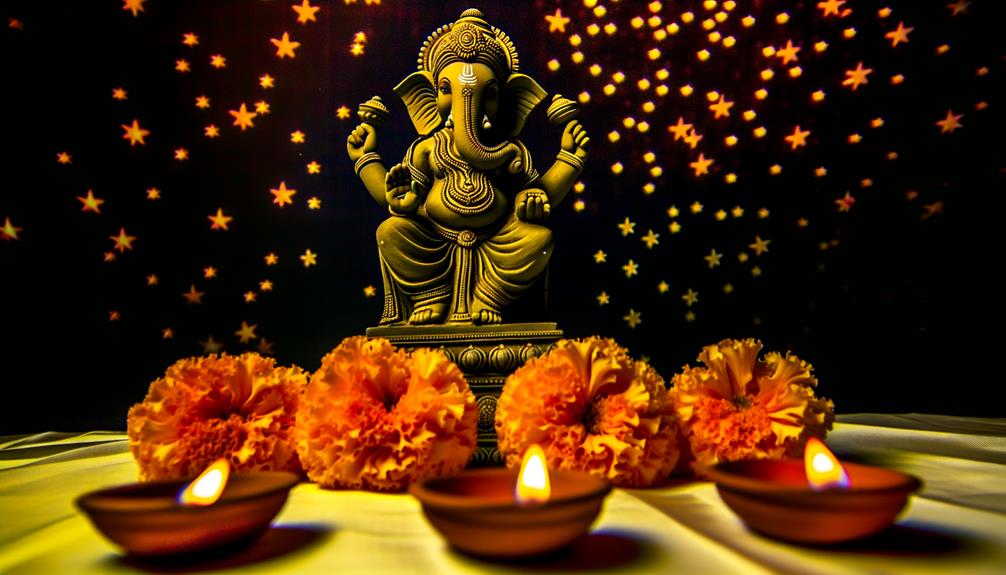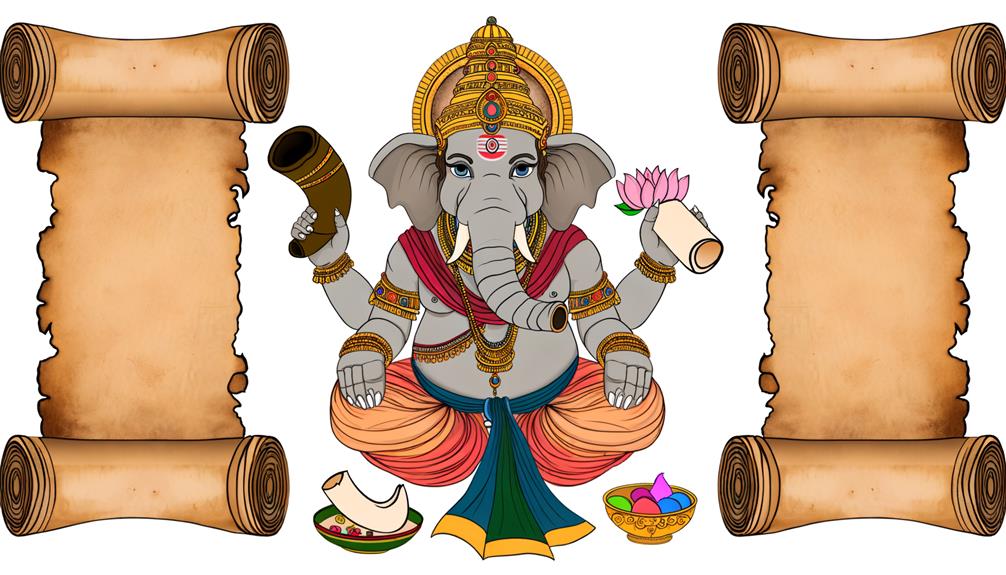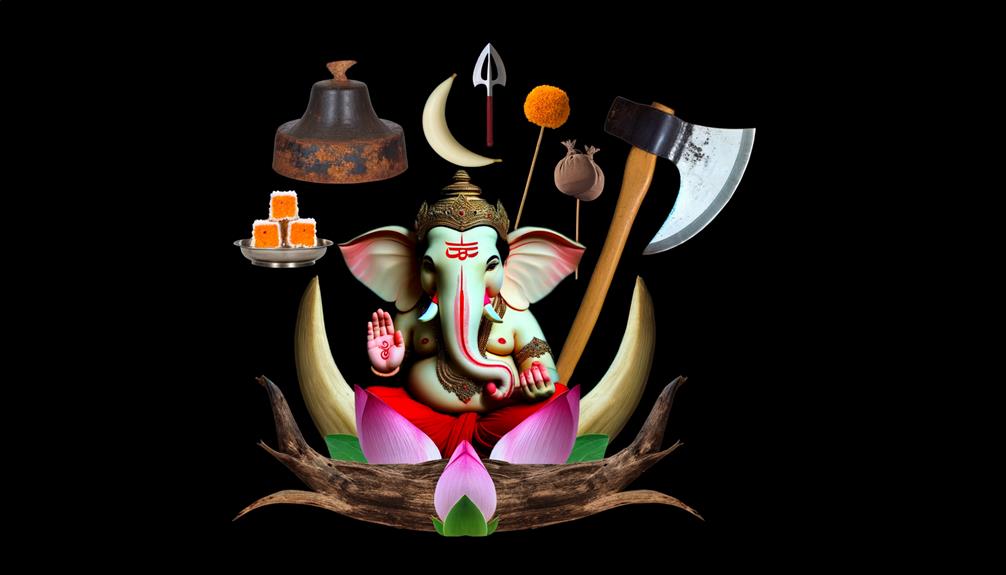Let's take a look at the vast selection of Hindu deities where Ganesha, the elephant-headed god, holds a distinctive position. Unlike the human-like Krishna or Rama, Ganesha's form is that of a gentle giant – an image that has always piqued my interest. Ganesha is a symbol of an elephant's power merged with the wisdom that we often associate with this respected creature.
Ganesha is revered as the one who eliminates hurdles and as the god of new beginnings. His origins are embedded in Hindu mythology, but his influence isn't limited to it. The deity's impact has also reached Buddhism and other cultures, thus forming an impressive cross-cultural connection.
Ganesha's depiction is rich with symbolism – the broken tusk, the potbelly, the four arms – each detail is a source of profound spiritual teachings. But what do these symbols truly mean? How has the role of Ganesha evolved within different traditions over time? We're about to delve into these questions in a way that feels more like a friendly chat than a lecture.
Keep in mind that the goal here isn't just to learn facts, but to gain insights that might give us a new perspective. So, let's get started on this captivating journey of understanding Ganesha.
Understanding Ganesha's Significance

Delving into the world of Hindu mythology, Ganesha stands out as a significant figure. You can't miss him with his elephant head and broken tusk, but it's his role as the eliminator of obstacles and the advocate for arts, sciences, and wisdom that really cements his importance. This deity, known for his elephantine features, is tied to intellect and wisdom, and is often invoked for luck before starting new endeavors. The essence of Ganesha lies not just in his physical appearance, but also in his profound influence.
People respect Lord Ganesha because of his ability to clear stumbling blocks and bless his followers with success. His impact stretches beyond the tangible world, influencing the spiritual development of his devotees. Various tales about Ganesha, including his birth, his gaining of an elephant head, the saga of his broken tusk, and his role in the massive epic Mahabharata, further clarify his significance. Each narrative holds a deeper spiritual message, highlighting traits like loyalty, wisdom, and resilience.
Ganesha Chaturthi, a significant Hindu festival dedicated to Ganesha, celebrates these attributes and his endorsement of knowledge. His followers seek his divine intervention before significant events or tests, invoking his wisdom and intellect. This ritual reflects the ongoing relevance and profound importance of this elephant-headed deity in Hindu culture.
Ganesha's Creation and Depiction
Let's take a closer look at the intriguing origin and representation of Ganesha, which highlights his esteemed position in Hindu mythology.
Ganesha, the son of Shiva, has a fascinating creation story. His mother, Parvati, desired a son and decided to shape Ganesha from the earth. Later, Shiva attached an elephant head to Ganesha, granting him wisdom and strength.
Ganesha's portrayal is full of meaningful symbols. We can understand this better by breaking down the symbolism associated with various aspects of his image:
- Elephant head and four arms: The head represents wisdom, and the four arms symbolize his omnipresence and power.
- Large ears and a potbelly: These represent the importance of listening and the capacity to process life's experiences, respectively.
Ganesha Chaturthi, a festival where idols of Ganesha are placed in homes and public spaces, helps refine our understanding of Ganesha's creation and representation. This event highlights Ganesha's significance and the deep impact of his unique symbolism.
When we comprehend the creation and representation of Ganesha, we see a deity who embodies wisdom, strength, and the power to overcome obstacles – a figure deeply loved and respected by Hindu communities around the globe.
Celebrating Ganesha Chaturthi Festival

Every year, when the vibrant months of August and September roll around, millions of people participate in the Ganesha Chaturthi festival. This ten-day event pays homage to Ganesha, the highly esteemed remover of obstacles and patron of arts and sciences. As we continue to learn more about Ganesha, the elephant god, it's interesting to examine the meaning behind this festival.
The Ganesha Chaturthi festival isn't just about the complex rituals. It's a deep expression of faith and devotion. When people place Ganesha idols in their homes and public spaces, they're symbolically inviting his divine presence into their lives. The prayers and hymns fill the air with a collective spiritual energy, strengthening the mythology that supports his power to overcome challenges.
The festival concludes with the Ganesha idols being submerged in water bodies. This symbolizes his journey back home, with the promise to return the following year. This act isn't just a goodbye, but a reminder of the cyclical nature of divine visitations.
In short, the Ganesha Chaturthi festival isn't just an annual event, but a spiritual journey. It's a celebration of Ganesha's role in Hindu culture and his support of arts and sciences. It's a timeless tradition that continues to thrive, reflecting Ganesha's ongoing significance.
Delving Into Ganesha's Stories

We've delved into the significance of the Ganesha Chaturthi festival, and now we're going to take a closer look at the intriguing tales and legends involving Ganesha. These stories shine a light on his embodiment of wisdom, strength, and the removal of obstacles in Hindu culture.
Let's start with Ganesha's birth story. His mother, Parvati, created him from the dirt on her body. His father, Shiva, initially didn't recognize him and mistakenly beheaded him. The replacement of his head with an elephant's signifies his rebirth and also represents wisdom and strength.
Let's break down some of these symbols:
- The elephant head: It represents wisdom and attentiveness.
- Large ears: They symbolize the capacity to listen more and absorb ideas.
- Small eyes: They signify the ability to concentrate on tasks.
The broken tusk: It represents sacrifice and the pursuit of knowledge. Ganesha used this tusk to write the epic Mahabharata.
These stories have been instrumental in establishing Ganesha as a remover of obstacles, guiding people through life's complexities. Looking deeper into these tales, we can grasp the complex symbolism within Ganesha's form and his widespread influence in Hindu culture.
Deciphering Ganesha's Symbols

Unearthing the symbolic meanings behind the form of Ganesha, we encounter a multitude of symbols, each with a deep connection to Hindu culture and spirituality. The process is akin to navigating a spiritual map, steering us through life's complexities.
His distinct elephant head represents wisdom, comprehension, and the critical thinking needed to achieve a fulfilling life. Ganesha carries a broken tusk, much like a pen, symbolizing sacrifice. It's a potent reminder that completing what we've begun often requires us to relinquish something we value.
The noose and axe that Ganesha holds are powerful symbols of overcoming difficulties and severing material ties. They stand for the necessary removal of hurdles, fostering spiritual growth.
Ganesha's potbelly, a notable aspect of this elephant deity, denotes the capacity to process both positive and negative experiences. His tiny mouse vehicle represents unchecked desires that can wreak havoc if not restrained. The sweet dumpling, or modak, in his trunk signifies the sweetness of self-realization. Each symbol, brimming with meaning, acts as a guide to deeper understanding.
Frequently Asked Questions
What Is the Significance of Ganesh the Elephant Headed God?
So, why is Ganesha, the god with the elephant head, so important, you might ask? Well, both in Hinduism and Buddhism, Ganesha holds a pretty big role. He's considered the go-to deity for clearing hurdles and is also associated with wisdom and strength. So, if you're seeking a bit of good luck or prosperity, a prayer to Ganesha might just do the trick!
How to Connect With Ganesh?
If you're looking to build a connection with Ganesh, one of the things I typically do is ask for his guidance, especially when starting something new. I engage in prayer, carry out traditional ceremonies, and gain a deeper understanding of the meanings behind his image. By knowing more about his narratives, it helps in nurturing a stronger spiritual rapport with this deity, who's often referred to as the Elephant God.
How Do I Ask Lord Ganesha for Help?
So, you're wondering how one can ask Lord Ganesha for help? Well, it's really quite straightforward. The first step is to seek his divine grace whenever I'm about to kick off something new. I pray with all sincerity, carry out rituals, and request his guiding hand, particularly during the celebration of Ganesha Chaturthi.
Does Ganesha Protect You?
Absolutely, according to Hindu beliefs, Ganesha does have your back. His role in mythology is that of a hurdle remover, providing safeguarding during tough transitions. Whenever I face rough patches, I often turn to him for his wisdom and strength.
Conclusion
When we delve into the world of mythology, the story of Ganesha stands out with its bright colors. Ganesha's unique shape and rich symbolism are more than just artistic impressions; they're whispers of divine guidance.
When we witness the Ganesha Chaturthi celebrations and hear tales of his wisdom and unwavering respect for his parents, we can see a way towards success and prosperity. Ganesha, the Elephant God, acts like a guiding light, illuminating a graceful and wise approach to life's complexities.

